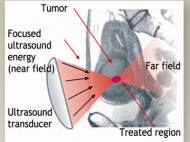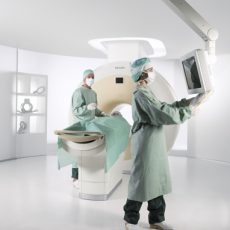Surgery done with sound – High-Intensity Focused Ultrasound
 A new ultrasound device, used in conjunction with magnetic resonance imaging (MRI), allows neurosurgeons to precisely burn out small pieces of malfunctioning brain tissue without cutting the skin or opening the skull. A preliminary study from Switzerland involving nine patients with chronic pain shows that the technology can be used safely in treating humans. The researchers now aim to test it in patients with other disorders, such as Parkinson’s disease. High-intensity focused ultrasound (HIFU) is different from the ultrasound used for diagnostic purposes, such as prenatal screening. Using a specialized device, high-intensity ultrasound beams are focused onto a small piece of diseased tissue, heating it up and destroying it.
A new ultrasound device, used in conjunction with magnetic resonance imaging (MRI), allows neurosurgeons to precisely burn out small pieces of malfunctioning brain tissue without cutting the skin or opening the skull. A preliminary study from Switzerland involving nine patients with chronic pain shows that the technology can be used safely in treating humans. The researchers now aim to test it in patients with other disorders, such as Parkinson’s disease. High-intensity focused ultrasound (HIFU) is different from the ultrasound used for diagnostic purposes, such as prenatal screening. Using a specialized device, high-intensity ultrasound beams are focused onto a small piece of diseased tissue, heating it up and destroying it.
“The groundbreaking finding here is that you can make lesions deep in the brain–through the intact skull and skin–with extreme precision and accuracy and safety,” says Neal Kassell, a neurosurgeon at the University of Virginia. Kassell, who was not directly involved in the study, is chairman of the Focused Ultrasound Surgery Foundation, a nonprofit based in Charlottesville, VA, that was founded to develop new applications for focused ultrasound.
The technology is currently used to remove uterine fibroids (small benign tumors in the uterus) and it’s in clinical testing for removing tumors from breast and other cancers. InSightec, an ultrasound technology company headquartered in Israel, has developed an experimental HIFU device designed to target the brain. The major challenge in using ultrasound in the brain is figuring out how to focus the beams through the skull, which absorbs energy from the sound waves and distorts their path. The InSightec device consists of an array of more than 1,000 ultrasound transducers, each of which can be individually focused.
The ultrasound beams are focused on a specific point in the brain that absorbs the energy and converts it to heat. This raises the temperature to about 55°C and kills the cells in a region approximately 10 cubic millimeters in volume. The entire system is integrated with a magnetic resonance scanner, which allows neurosurgeons to make sure they target the correct piece of brain tissue.
The Swiss study, published this month in the Annals of Neurology, tested the technology on nine patients with chronic debilitating pain that did not respond to medication. The traditional treatment for these patients is to use one of two methods to destroy a small part of the thalamus, a structure that relays messages between different brain areas. Surgeons either use radiofrequency ablation, in which an electrode is inserted into the brain through a hole in the skull, or they use focused radiosurgery, a noninvasive procedure in which a focused beam of ionizing radiation is delivered to the target tissue.
According to the new study, all nine patients reported immediate pain relief after the outpatient procedure and were up and about soon afterward. The patients did report feeling a few seconds of tingling or dizziness, and in one case a brief headache, as the targeted tissue heated up, he says. But none experienced neurological problems or other side effects after surgery.
“This will give a lot of impetus for manufacturers of focused ultrasound equipment to get interested in the brain,” says Kassell. An experimental version of InSightec’s ultrasound device is currently being tested in five medical centers around the globe. In addition to using it with Parkinson’s patients and those who suffer other movement disorders, scientists plan to test the technology as a treatment for brain tumors, epilepsy, and stroke.
One downside of HIFU compared to the more invasive neurosurgeries performed with an electrode is that surgeons are unable to functionally test whether they have targeted the correct part of the brain. During traditional surgery for Parkinson’s, for example, the neurosurgeon stimulates the target area with the electrode to make sure he or she has identified the piece of the brain responsible for the patient’s motor problems, and then kills that piece of tissue.










Once it was lasers and now sound to cure diseases.
Dr.A.Jagadeesh Nellore(AP),India